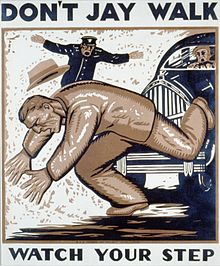In some cities, cameras scan train stations for the most wanted. Billboard-sized displays show the faces of jaywalkers. Facial recognition scanners guard housing complexes.
Jaywalking occurs when a pedestrian walks in or crosses a roadway illegally. The term originated with "jay-drivers", people who drove horse-drawn carriages and automobiles on the wrong side of the road, before taking its current meaning.[1]
The term "jaywalking" is used largely in the United States where rules applicable to pedestrians are less permissive than in countries such as the United Kingdom.[2] Legal texts in other countries use different concepts, such as Rules applicable to pedestrians in the Vienna Convention on Road Traffic.[3] One member of this convention, the United Kingdom, does not have jaywalking laws; its Highway Code relies on the pedestrian making their own judgment on whether it is safe to cross based on the Green Cross Code. Pedestrians do have priority over turning vehicles. Rule 170 of the UK's Highway Code states that a driver should "watch out for pedestrians crossing a road into which you are turning. If they have started to cross they have priority, so give way."[4]
Contents
[hide]Origin of the term[edit]
The word jaywalk is not historically neutral.[5] It is a compound wordderived from the word jay, an inexperienced person and a curse word that originated in the early 1900s, and walk.[6] No historical evidence supports an alternative folk etymology by which the word is traced to the letter "J" (characterizing the route a jaywalker might follow).
While jaywalking is associated with pedestrians today, the earliest references to "jay" behavior in the street were about horse-drawn carriages and automobiles in 1905 Kansas: "jay drivers" who did not drive on the correct side of the street.[1] The term swiftly expanded to pedestrians, and by 1909, The Chanute Daily Tribune warned "The jay walker needs attention as well as the jay driver, and is about as big a nuisance."[1]
The word was promoted by pro-automobile interests in the 1920s, according to historian Peter D. Norton.[7]
Originally, the legal rule was that "all persons have an equal right in the highway, and that in exercising the right each shall take due care not to injure other users of the way".[8] In time, however, streets became the province of motorized traffic, both practically and legally. Automobile interests in the USA took up the cause of labeling and scorning jaywalkers in the 1910s and early 1920s, by then the earlier term of "jay driver" was declining in use.[9][10] The earliest citation in the Oxford English Dictionary follows in 1917.

沒有留言:
張貼留言